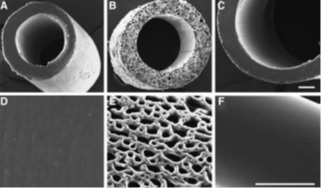Improved Nerve Conduits for Treatment of Peripheral Nerve Injuries

Scanning electron microscope image of conduits
Invention Summary:
Nerve conduits are used for treatment of peripheral nerve injuries. However, the current conduits are associated with poor healing resulting from swelling and reduction of luminal volume, suture pull-out, collapse, kinking, compression, and lack of mechanical strength to withstand the traction of moving joints.
Rutgers scientists have developed an improved biocompatible nerve conduit for nerve re-generation, where a porous fiber tube is coated with a bioresorbable hydrogel. The fibers are formed from a resorbable, biocompatible polymer that supports axon growth by preferential adsorption of endogenous proteins. The fibers are braided with pores in the range from 5 to 200 micrometers using a kink-resistant braiding pattern. The hydrogel coating material and thickness are selected to control the overall porosity, so that nutrients and oxygen can diffuse through the hydrogel coating but the infiltration of fibrous tissue through the coating is prevented.
Advantages:
- Supports axonal growth
- Adjustable and optimal rate of degradation and bioresorption of conduits
- Enhanced compressive strength and resistance to kinking and stretching
- Improved oxygen and nutrient diffusion
- Prevents infiltration of fibrous tissue
Market Applications:
- Clinical use in the treatment of peripheral nerve gaps up to about 3 cm
- Repair and bridging of other tubular structures such as bile duct and urethra
- Wound care and wound healing
Intellectual Property & Development Status:
- Issued patents: US 10,940,235, EP 3283137, and JP 6733890
- Patents pending in CA, CN, HK, PL, FR, DE, IE, IT, PL, and ES
- Available for licensing and/or research collaboration
Patent Information:
| Title |
App Type |
Country |
Serial No. |
Patent No. |
File Date |
Issued Date |
Expire Date |
Patent Status |
|
|
|
ID: 2015-014
Category:
Inventors:
Keywords:
|